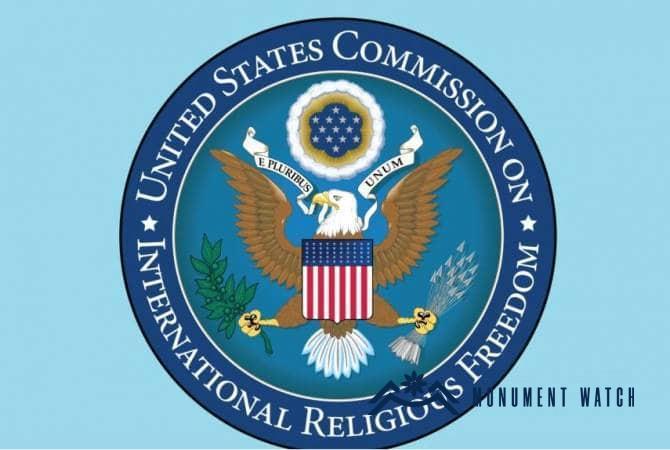
Addressing the theme of the destruction of Armenian cultural heritage by Azerbaijan in the occupied territories of Artsakh in the annual report of the US Department of State Committee on Religious Freedoms for 2021
In April 2022, in the annual report of the International Committee on Religious Freedom of the US Department of State, assessed the religious freedom in Azerbaijan in 2021 generally as negative, including the problems of protecting religious and cultural heritage (destruction, elimination and falsification of the historical facts) in Artsakh (according to the document - Nagorno Karabakh), the state of which has become more alarming in the territories that came under the control of Azerbaijan as a result of the ceasefire signed between Armenia and Azerbaijan in November 2020.
Although the Azerbaijani media have recently spared no effort to distort the entire content of the report by spreading disinformation, nevertheless, both in the short and full text of the report, the destruction of Armenian cultural property and state policy on this matter are mentioned in detail, referring to both history and our days.
In particular, the annual report of the US Commission on Religious Freedom is based on satellite imagery captured by Caucasus Heritage Watch showing the destruction of two Armenian cemeteries, a mosque and several churches. Although it has already been recognized as an international crime (PACE resolutions, the International Court in The Hague), nevertheless, it remained unpunished by Azerbaijan. In 2020, the Azerbaijani government announced that two soldiers would be charged with destroying Armenian tombstones, but the authorities refused to release any information about these incidents. The report based on CHW satellite imagery, documents on the destruction in 2020 of Armenian cultural and religious sites in June-September and says they are still in danger today due to construction.
The report mentions recent unique precedents by important international bodies, where they considered significant the December decision of the International Court of Justice, calling on Azerbaijan to “take all necessary measures to prevent, punish, vandalize and desecrate actions related to the cultural heritage of Armenia, ... including churches and other places of worship, ... cemeteries”, as well as several PACE resolutions “in connection with the destruction of the Armenian cultural heritage in Nagorno-Karabakh”.
The report, with reference to important parts of the PACE resolution, confirms their importance, especially "the deliberate damage to cultural heritage during the Six Weeks War, as well as the deliberate shelling of the Cathedral of the Holy Savior of Shushi, the destruction or elimination of other churches and cemeteries during and after the conflict." The Global Religious Freedom Report for 2021 by the US State Department establishes for the first time Azerbaijan's ongoing destruction of Armenian monuments as a unique international precedent.
In particular, the propaganda of "Albanization" of Azerbaijan in order to deny the Christian heritage of Artsakh and the Armenian identity. is criticized. In this regard, the organization proposed that the US government provide funding to the Agency for International Development (USAID) and the US Embassy in Baku, with the aim of reconstructing, preserving and protecting places of worship, religious or cultural sites in Nagorno-Karabakh.
The report condemned Azerbaijan's policy of Albanianization of Armenian churches, citing a statement by the Azerbaijani Foreign Ministry on May 4 that the reconstruction of the Church of the Holy Savior in Shushi, funded by the Azerbaijanis, should be carried out "in accordance with the original architectural style", but as a result it turned out that that the temple is also considered to be an "Albanian" heritage. The report says that the Armenian side is convinced that such statements are an attempt to hide the Armenian roots and structure of the church, including the original appearance of the dome of the church.
Acting Minister of Education, Science, Culture and Sports of Armenia Vahram Dumanyan in his letter to UNESCO accused Azerbaijan of actively pursuing a "policy of falsifying historical facts" when declaring Armenian cultural heritage sites in the occupied territories "Caucasian-Albanian".
In its report, the U.S. State Department expressed concern about problems with Armenian pilgrims visiting Dadivank after the ceasefire agreement in November 2020, saying it was difficult for Armenian pilgrims to visit it throughout the year, and in February-April, two groups were banned from entering the monastery. It is especially noteworthy that the report spoke not only about the destruction of Armenian cultural property during the war, but also about the destruction of Nakhichevan.
In June, The Art Newspaper, using satellite imagery, published a report on the destruction of medieval Armenian churches at Agulis in Nakhichevan. Churches were present in the 1977 photographs, but they no longer existing in the photographs of 2016 and 2019. Among those are Surb Stepanos, Surb Tovma, Surb Christapor, Surb Hovhannes Mkrtich, Great Hermitage Surb Astvatsatsin and Surb Hakob Hayrapet.
The Art Newspaper also reported on the destruction of Armenian heritage throughout Nakhichevan, which once included 89 churches, 5,840 khachkars and more than 22,000 tombstones, according to documents collected by independent researcher Argam Ayvazyan in 1964-87.